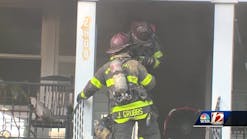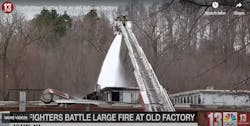An increasing number of towns are charging for fire department services as they look for new revenue sources.
``Like a lot of urban areas right now, we're struggling financially,'' Dayton Fire Chief Larry Collins said. ``And it's very difficult to raise taxes at this time given our tax rate.''
Susan Smith, who drives to her job at Sinclair Community College in Dayton, called the fee outrageous.
``I think I'll keep a mop in my car and mop up my own spill,'' said Smith, 39, of suburban Miami Township. ``It's going to cause a lot of people to be upset.''
Smith said she will be less likely to vote for a tax increase to fund the fire service now that this fee is being imposed.
Wendy Feerer, 29, of suburban Kettering, said fire departments responding to traffic accidents should be a public service.
``I kind of think it's a bad idea because it will drive insurance rates up,'' she said.
The new fee, approved last week by the City Commission, is levied against the person that police determine is responsible for the accident.
Collins said he expects insurance companies to cover most of the fees. And he said it is one way to recoup money from out-of-town, just-passing-through motorists who use fire department services at an accident but pay no local taxes.
The fee is about half the cost of an average fire run with one engine, Collins said. He expects the fee to generate as much as $300,000 in the first year and as much as $400,000 in subsequent years.
The money will be used to buy new fire engines and other equipment.
Susan Cave, director of the Ohio Municipal League, said the move to charge motorists for fire services illustrates the desperation of financially strapped cities.
``Revenues are down. Costs of doing business is up,'' Cave said. ``They're just scrambling for dollars to just keep their basic services.''
Cincinnati began charging motorists for fire calls in January, with a minimum fee of $549. So far, the city has collected about $20,000.
``It hasn't been very successful,'' said Mike Kroger, assistant fire chief. ``It's far less than we expected to get out of it.''
Kroger said he thinks insurance companies have been slow to pay because the policy is new and insurers have questions about it.
But the lure of tapping into new revenue sources have some cities thinking about jumping on the bandwagon. The Cleveland suburb of Parma is considering imposing a fire-service fee on non-resident motorists involved in accidents.
Columbus-based HealthServe LLC handles such fees for 25 fire departments around Ohio, up from only five two years ago.
``Without a doubt, it's a rapidly growing trend,'' said Glenn Goodpaster, executive vice president of business development.
Goodpaster said such fees now are assessed routinely in Texas, Indiana, Michigan and Pennsylvania. And he said 15 more interested Ohio municipalities plan to attend a presentation by HealthServe in Akron on Thursday.
Goodpaster said the fees shouldn't result in increased insurance rates because they represent a small fraction of the cost of the accident. He said the average traffic accident HealthServe deals with results in $8,000 in property and personal damage, but only $650 in fire department fees.
Brian Maze, public policy specialist for the State Farm Insurance Co., disagrees.
``Increased claim costs can increase premiums,'' Maze said.
He said State Farm has recently been receiving claims from fire departments for these services and expects to see an increase with more departments imposing the fees.
However, he said there is no provision in State Farm policies that requires payment of such fees, other than the portion that involves medical treatment and transport to hospitals. Maze said State Farm has been sending letters to the fire departments questioning the fees and has yet to pay them, other than the medical portion.
The city of Franklin, south of Dayton, established service fees in 2002 so it could enlarge its fire department and keep a tax increase for the project to a minimum.
The department charges $500 to $700 to respond to traffic accidents, house fires and hazardous-materials spills. So far it has raised $78,000 and in all but five cases insurance covered the fees, said Fire Chief Jonathan Westendorf.
``As a whole, the community is able to pay less for fire service because the people who actually use the services are paying for the services,'' Westendorf said.





